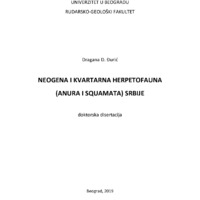Neogena i kvartarna herpetofauna (Anura i Squamata) Srbije : doktorska disertacija
Објеката
- Тип
- Докторска дисертација
- Верзија рада
- објављена
- Језик
- српски
- Креатор
- Dragana D. Đurić
- Издавач
- Beograd : Rudarsko-geološki fakultet
- Датум издавања
- 2019
- Ментор
- Katarina Bogićević
- Члан комисије
- Draženko Nenadić, Nevenka Đerić, Tanja Vukov
- Сажетак
-
U radu je prvi put opisan deo herpetofaune (Anura i Squamata) iz neogenih i kvartarnih lokaliteta Srbije. Obrađeni su lokaliteti Sibnica, Prebreza, Lazarevc, Vračević i Riđake, neogene starosti. Lokaliteti kvartarne starosti su pećine Mala i Velika Balanica, Pešturina, Hadži Prodanova, Baranica, Vrelska pećina i sedimentne ispune fisura u kamenolomima Venčac i Beočin. U radu je prikazana je taksonomska analiza herpetoloških ostataka. Pored taksonomske analize fosilnog materijala dat je kratak geografsko-geološki opis proučavanih lokaliteta, osnovne osteološke karakteristike anura i skvamata kao i njihove tafonomske karakteristike. Taksonomska analiza je obuhvatila 2300 primeraka koji su uvršteni u 35 taksona. Ukupno su identifikovane su 23 vrste i 9 rodova iz 15 porodica. Deo materijala određen je samo do nivoa familije (5) i potfamilije (1). Prvi put su za teritoriju Srbije opisani sledeći taksoni: Agama Daudin, 1802; Gekkonidae gen. et sp. indet.; Zootoca cf. Z. vivipara (Lichtenstein, 1823); Pseudopus cf. P. laurillardi (Lartet, 1851); Pseudopus cf. P. pannonicus Kormos, 1911; Varanus White, 1790. Detaljno su opisani i nedavno objavljeni taksoni: Latonia gigantea (Lartet, 1851); Palaeobatrachus Tschudi, 1839; Chamaeleonidae gen. et sp. indet.; Elaphe quatuorlineata (Lacepede, 1789); Zamenis paralongissimus (Szyndlar,1984); Hierophis viridiflavus (Lacepede, 1789); Telescopus cf. T. fallax Fleischmann, 1831; Malpolon cf. M. monspessulanus (Hermann, 1804).
Nakon tafonomske, stratigrafske i paleoekološke analize, kao i iz uporednih podataka iz literature i najnovijih istraživanja, utvrđena promena u sastavu i distribuciju taksona herpetofaune vezana za moguće promene paleoekolških uslova od kasnog donjeg miocena do gornjeg pleistocena. Dobijeni rezultati su iskorišćeni i za tumačenje nekadašnje geografske distribucije herpetofaune na prostoru današnje Srbije. Detaljna morfološka analiza pokazala je veliko bogatstvo i raznovrsnost paleoherpetofaune za period od donjeg miocena do gornjeg pleistocena. -
The part of herpetofauna (Anura and Squamata) from the Neogene and Quaternary sites of Serbia as the subject of this dissertation was described for the first time. The Sibnica, Prebreza, Lazarevac, Vracevic and Riđake as Neogene sites and Mala and Velika Balanica caves, Pesturina, Hadzi Prodanova, Baranica and Vrelska cave, fissure fillings of the Venčac, Beočin quarries as Quaternary localities were processed.
The paper presents a taxonomic analysis of herpetological remains. In addition to the taxonomic analysis of fossil material, a short geographical and geological description
of the studied sites, the basic osteological characteristics of the anura and squamata, as well as their tafonomic characteristics were given. Taxonomic analysis included 2300 samples that were classified into the 35 taxa, total of the 23 species and 9 genera from 15 families have been identified. A part of the material was determined only to the level of the family (5) and subfamily (1).
For the first time in the Serbia the following taxa were described: Agama Daudin, 1802; Gekkonidae gen. et sp. indet.; Zootoca cf. Z. vivipara (Lichtenstein, 1823); Pseudopus cf. P. laurillardi (Lartet, 1851); Pseudopus cf. P. pannonicus Kormos, 1911; Varanus White, 1790. The recently published taxons are also described in detail: Latonia gigantea (Lartet, 1851); Palaeobatrachus Tschudi, 1839; Chamaeleonidae gen.
et sp. indet.; Elaphe quatuorlineata (Lacepede, 1789); Zamenis paralongissimus (Szyndlar, 1984); Hierophis viridiflavus (Lacepede, 1789); Telescopus cf. T. fallax
Fleischmann, 1831; Malpolon cf. M. monspessulanus (Hermann, 1804).
The comparative tafonomic, stratigraphic, paleoecological analysis, as well as comparison of literature data and the recently published studies, give confirmation of
temporal variation in distribution of taxa in herpetofauna with inicated possible changes in paleoecological conditions from the late Lower Miocene to the Upper Pleistocene. The obtained results were also used for the interpretation of the former geographical distribution of herpetofauna in the area of today's Serbia. A detailed morphological analysis showed the great wealth and diversity of paleoherpetofauna during the period from the Lower Miocene to the Upper Pleistocene. - број страница
- 149, [14] lista
- Просторно покривање
- Srbija
- Subject
- paleoherpetofauna, Anura, Squamata, kvartar, pleistocen, neogen, Srbija, paleoekologija, paleoklima
- paleoherpetofauna, Anura, Squamata, Quternary, Pleistocene, Neogene, Serbia, paleoecology, paleoclimate
- УДК број
- 56.012.2(497.11)(043.3)
- COBISS број
- 1025554663
- Шира категорија рада
- M70
- Ужа категорија рада
- M70
- Права
- Отворени приступ
- Лиценца
- Creative Commons – Attribution-NonComercial-No Derivative Works 4.0 International
- Формат
- Медија
 Djuric_Dragana_bp.pdf
Djuric_Dragana_bp.pdf
Dragana D. Đurić. Neogena i kvartarna herpetofauna (Anura i Squamata) Srbije : doktorska disertacija, Beograd : Rudarsko-geološki fakultet, 2019 M70
This item was submitted on 19. септембар 2019. by [anonymous user] using the form “Теза” on the site “Радови”: http://drug.rgf.bg.ac.rs/s/repo
Click here to view the collected data.